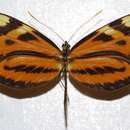en
names in breadcrumbs


Mechanitis lysimnia, the confused tigerwing, sweet-oil tiger[2] or lysimnia tigerwing, is a species of butterfly of the family Nymphalidae. It was described by Johan Christian Fabricius in 1793. It is found in Central and South America, from southern Mexico to Uruguay. The habitat consists of disturbed forests at altitudes up to 1,500 metres (4,900 ft).
Adults have been recorded feeding on nectar from Eupatorium flowers.
The larvae are gregarious and feed on Solanum species and possibly other members of the family Solanaceae. They are pale green streaked with yellow.[2]
Mechanitis lysimnia, the confused tigerwing, sweet-oil tiger or lysimnia tigerwing, is a species of butterfly of the family Nymphalidae. It was described by Johan Christian Fabricius in 1793. It is found in Central and South America, from southern Mexico to Uruguay. The habitat consists of disturbed forests at altitudes up to 1,500 metres (4,900 ft).
Adults have been recorded feeding on nectar from Eupatorium flowers.
The larvae are gregarious and feed on Solanum species and possibly other members of the family Solanaceae. They are pale green streaked with yellow.